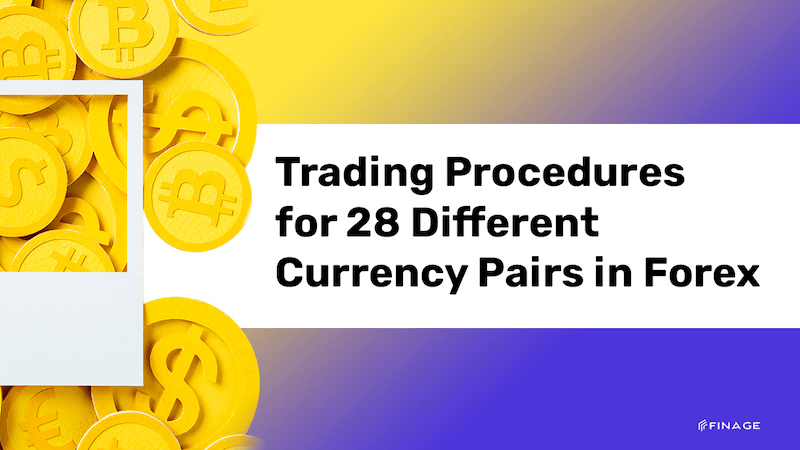Trading Procedures for 28 Different Currency Pairs in Forex
5 min read • September 26, 2022

Introduction
When To Get Into A Forex Trade
By the end of this article, readers will have a thorough understanding of how to enter and manage forex trades involving 8 different currencies and 28 different currency pairs.
Here, we'll teach forex traders how to spot emerging and developing tendencies on H4 and beyond. In addition, we'll demonstrate how to verify the trade entry, set up expert alerts and notification systems, and calculate the pip potential of each trade. We then instruct traders on proper trade management, including the use of initial stops, break-even stops, and lot sizing.
Finding The Big Picture Trend
Traders can use a few basic trend indicators across multiple time frames in their charting software. Next, apply the principles of multi-timeframe analysis to see which currency pairs are currently trending or showing signs of becoming trending. The image below is a good illustration of such trend indicators.
For easier analysis, traders should always classify their trend indicators by different currencies. It's important to compare pairs side by side to make sure everything is aligned; in this case, all JPY pairs. This is applicable to all 28 possible combinations of the top eight currencies, including the USD, CAD, EUR, CHF, GBP, AUD, and NZD.
Then, you should look at the larger time frames (H4 and above) for each set of currencies to determine which pairs are trending higher or lower. Find currency pairs that are just beginning new trend cycles.
Warning Methods
Any time the forex market is open, there is the potential for movement. However, 80% or more of the best entries are made during the regular trading day. Since the market is always open, traders have to be efficient with their time and know exactly when to check it for a trade entry. Your trading schedule is extremely dependent on the alert system you employ.
Several types of alert systems are essential for a professional trading platform. To keep up with the market during the day's main trading session, try using a combination of the following: a desktop market scanner, an audible price alert, an email price alert, a currency strength mobile app for desktop notifications and mobile devices, and periodic manual observation. Here are some examples of professional forex alert systems that can inform traders of market fluctuations.
The Process of Verifying a Business's Right to Enter a Trade
Traders need to double-check their trade entry when alert systems suggest the market or a subset of pairs may be about to move. The Forex Heatmap ®, a graphical representation of the forex market that provides real-time buy and sell signals, is used to confirm all trades. In the sample trades that follow, you'll see two instances of the heatmap in action. Traders also need to double-check their targets and support/resistance levels. A valid trade would be one in which a buy signal appeared on the heatmap for a given currency pair and there was at least 100 pips of potential to the next resistance area. Most of our trade entries aim for 100-125 pips, so we can expect a positive risk-to-reward ratio of at least 4:1.
Market Participation Model
Here are a couple of sample trade entry scenarios across multiple currency pairs. The exact same methods of purchase and sale apply to all twenty-eight possible combinations.
The Australian dollar (AUD) is weak, and a trader receives an alert from one of the listed alert systems that the price of the AUD/USD has dropped (either due to a price breach or a mobile app notification). To see if a trade is feasible, you look at the signals from the trend and heatmap. You should ensure there are no support levels within 150 pips of the current AUD/USD price on the D1 time frame and that the pair is trending down. Then, you look at the signals on The Forex Heatmap ® to see if the AUD is weakening or the USD is strengthening. Because the AUD has been so consistently weak, you've been selling the AUD/USD. If the D1 time frame is trending down, you can use the smaller time frames and heatmap to enter a sell trade.
When To Get Into A Forex Trade
Live heatmap signal and M15 time frame displaying AUD/USD decline of 75 pips. Trading in other AUD pairs, such as shorting the AUD/CHF or the AUD/JPY, was also possible with these signals.
A Second Illustration: Trade
In the second scenario, a trader's mobile phone receives a push alert warning that the JPY is weak. After researching the market and charts, they decide to purchase JPY pairs. Once again, the heatmap data is reliable and robust. We recommend that all traders do what this trader has done and view all of the JPY pairs on one screen.
The Forex Heatmapreal-time ®'s trading signals are a good fit for this particular chart. This is the most effective trading strategy and chart setup for forex traders. As an added bonus, this method will help you limit the amount of money you lose during a trading session if you are using a funded trading account. On this day, there was a total change of 900 pips in the JPY pairs.
Commercial Management
The trader can manage the trade by increasing the trade size as the AUD/USD falls further into a downtrend on time frames larger than the H4. If, on the other hand, the AUD/USD is trending upwards across all time frames, the trader should get out of the trade entirely and treat it as a day trade or intraday sell position. Similarly. Scaling out your lots and moving your stop to break even can help you make more money in a trending market if the JPY pairs you traded are trending up on at least the H4 time frame.
Putting It All Together: A Guide to Making Forex Trades
This article provides a comprehensive approach to trading 28 different currency pairs. Traders now have access to knowledge and tools for managing trades, including trend indicators, entry management tools, professional alert systems like push alerts, and more.
You can get your Real-Time and Historical Forex Data with Finage free Forex Data API key.
Build with us today!
Claim Your Free API Key Today
Access stock, forex and crypto market data with a free API key—no credit card required.

Stay Informed, Stay Ahead
Finage Blog: Data-Driven Insights & Ideas
Discover company news, announcements, updates, guides and more


